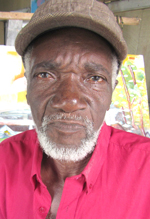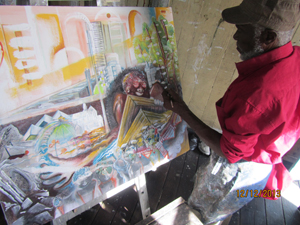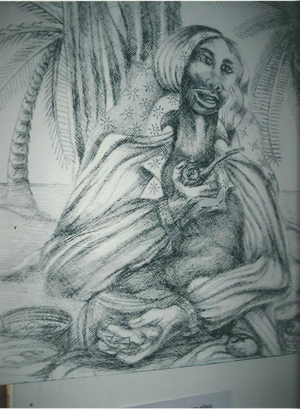Latest update March 31st, 2025 5:30 PM
Latest News
- Bandits cut through roof to rob WBD Supermarket
- Court Orders “Critic” to pay the Mohameds $52M
- ExxonM and CNOOC sticking to 11B barrels figure in Stabroek Block, but Hess says estimate higher
- Deadly Israeli strikes mar Gaza Eid celebrations
- Govt. to roll out automated speed ticketing system next week
Drawing his way to success…Artist Winston Strick M.S. is a ‘Special Person’
Dec 15, 2013 News
“I always had a liking and passion for art. In growing up, as a young person—friends would have their hobbies, and my hobby was art. My father wouldn’t encourage comic books and cinema-going and things like that. I used the art as an alternative.”
By Leon Suseran
Our ‘Special Person’ this week saw himself a budding artist since he was a teenager. He agrees that it was perhaps the love for art by his parents that pushed him to nurture the talent.
Winston Strick recalls his father not being too enthused with him picking up a book or doing what the other children in the village were doing, rather, his father gave him enough of the time he needed to be by himself away in the village, concentrating, letting the ideas flow—drawing!
Winston’s work is today highly regarded for its mastery of technique, its usual wit and elegance of presentation. Many of his pieces contain social commentary, others celebrate individuals; all express sincerity, while others celebrate individuality of vision and commitment to skilled craftsmanship.
He attended the St. Aloysius R.C. Boys’ School followed by the Berbice High School. He was also the Art Master at the Government Teachers’ Training College, In-Service branch in 1964. He also taught various subjects at the Berbice High School in 1966, including English Language, English Literature, Religious Education, and of course, Art.
“My parents—my mother, Venus, was always into sewing machines; she was into craft and used to take us into the back dams to cut awara and make hats and all these things and my father, Mc Bean, used to do a lot of cabinet and furniture making, so I grew up in that kind of environment.”
Strick remembered how it all started, with him “trying a thing” with wood and then covering it with straps to make footwear. One of his first efforts to get into formal art training in the town of New Amsterdam was due to the encouragement of a friend, a class taught by Mr. Heyliger, a product of the Working People’s Art Class, a functioning body at that time in Georgetown spearheaded by Mr. E. R. Burrowes.
Another of his inspirations in those days to pursue the field of art was the British Council, which had offices all over, including New Amsterdam, “and they would show films on art and on the culture and they had books that you borrowed.”
In 1969, he left these shores to further his academic and professional skills in the field which he loved. He studied Architectural Drafting and Fine Arts at the Brooklyn Museum of Art (BMA) and pursued more training at New York University (NYU)’s School of Continuing Education.
“I was apprenticed to Interior Decorator Joe Lasco while in New York, who taught me about restoring art works. I knew that those were the prerequisites, so I did some of that. But even before I left Guyana, I was practicing fine arts, because I can remember having a collection of works.
I took my first collection of works to Colleen Taitt, who had an art movement in Middle Street (where Cara Lodge exists today), and we used to go there and have meetings and she used to have a place to exhibit…and it was during one of those trips I was privileged to meet E.R. Burrowes, in the company of the very famous Donald Locke.”
In 1974, Strick worked with the Ministry of Information and Culture and played a critical role in the establishment of the National Trust, working under the distinguished A.J. Seymour, A.A. and the scholarly Dr. Dennis Williams, A.A. As inaugural secretary, he oversaw the designing, creation and erection of the 1763 Monument, Enmore Martyrs’ Monument, etc. He pioneered two videos for the restoration of the forts in Guyana. He was also the Public Relations Officer (PRO) for the Jaycees of Guyana.
“In 1977, after exhibiting leather jewellery at the Theatre Guild, I launched my Art career with a fashion-show at the Umana Yana, an event which Former First Lady, Mrs. Viola Burnham, O.E., opened….I supported Roots and Culture Movement in re-establishing its Art Gallery and producing a collection of leather art for that organization, and there, I made three videos on Fine Arts with Errol Brewster.”
Winston Strick held numerous one-man exhibitions (during the period 1977-1994) at his home in Brooklyn, USA; Boa Vista, Brazil in 1981; and during Carifesta in Barbados in 1982, as well as in New Amsterdam and Rose Hall. His works are mainly wooden sculptures, leathers and painting. He loves to do leather craft and art.
“Stretching of a canvas was a technique that we never knew in Guyana, and people used tentest to paint on— but it was unlike the real canvas and that called for stretching, and that was not a very common practice, and I had to acquire that skill by going abroad (at Art School).”
Strick recalls his artwork being sought after by the Ministry of Foreign Affairs (during previous administrations) and other agencies, and being presented as gifts and tokens to dozens of dignitaries and Heads-of-State. He vividly recalled then Minister of Foreign Affairs, Mr. Rashleigh Jackson, an art collector himself, “encouraged these diplomats to relate to our art and buy them…also American Ambassador, Ms. Theresa Tull… I made 10, 12 pieces at one time for them…she had a few pieces for her collection.”
Strick was involved, too, in planning costumes for several Mashramani celebrations in Guyana including in 1984 and 1986. He taught Leather Craft at the Burrowes School of Art for a few years.
“I always had a liking and passion for art. In growing up, as a young person—friends would have their hobbies, and my hobby was art. My father wouldn’t encourage comic books and cinema-going and things like that. I used the art as an alternative.”
In 1991, for his sterling contributions to the field of Art in Guyana, Mr. Strick was bestowed the Medal of Service by the former President of Guyana, the late Hugh Desmond Hoyte.
When asked what is the recipe for an excellent artist, Strick said that you have to make a piece that can stir the feelings and appreciations of persons, “the creativity must be there, but it must make that impact so when persons see it, they must light up—that is what artists strive for—so that they can have this bang!” And he names his pieces—all of them! He is currently working on “The Epiphany” for the past two weeks.
So how do these ideas come to our ‘Special Person’?
“The ideas come easily, but when you’re just beginning, you have to learn to think—meditate— and visualize, and bring your concepts…try to see things in your mind before you bring them out, so you learn this technique as you go about how to visualize things and breathing and seeing what other artists do, [and] you learn from that.”
Being a good artist, he said, demands a lot of peace and quietude. Mr. Strick lives by himself in Stanleytown, New Amsterdam, and says he gets “lots of peace and quietude so I can concentrate on my works and get the ideas and creative juices flowing.”
Strick invented new techniques in tie craft and leather, too.
His advice to young artists our there is “try to understand the road that the artists before you—like Philip Moore and Dennis Williams—try to know how they carried on their careers and that will be a guide…”
As for being a part-time artist, Strick said that, “I believe that if you like something, you will put your whole life into it…so art can be a full-time thing, but you have to know how to manage your career and how to guide it, but if you can follow the trend of older artists, that can be your guide.”
Today, he focuses a lot on leather accessories—one of which he is working on now
“I found that I had an easy run trying to make accessories out of leather—it was something new and in my own little way—I think I have perfected it to good standards over the years and I feel good about that. I use the hide of cattle of the Rupununi. Such leather can be sliced or scraped thin, wet with water, pressed, shaped and moulded; heated to maintain its rigidity; burnished with water or Vaseline to enhance its texture and colouration; cut and undercut.”
When asked about the state of art and the industry in Guyana today, he asserted “as far as the infrastructure—if you want to use that word— is concerned, it is encouraging. The art market used to be better years ago, but I still think it’s actually quite good today because with university, people are becoming more educated and relating more to the arts, so it’s supposed to be good. It’s probably because I am a senior artist that it is not so difficult to survive, but then again it is not so easy as it should be, so I am hoping for changes.”
Strick has won several prizes for painting, craft and sculptures, from the likes of the Ministry of Culture, Banks DIH, and Demerara Distillers Limited. Sheik Sadik, A.A, he added, in his ‘Sugarcane’ series, and Diane Morrison, are among writers who have included him and his works in their writings. Francis Quamina Farrier, A.A. and Stella Walcott, too, have interpreted poems from his published ‘Voices and Visions’ (1978) for stage presentations.
Last August, Strick hosted an exhibition at the New Amsterdam Town Hall in commemoration of the 175th Anniversary of the Emancipation of African Slaves in Guyana. This event was co-hosted by the Council of Friends of New Amsterdam (COFONA), a body which presented him with a sculpted piece of art, for his hard work and efforts in the field.
Certainly, Guyana has benefitted from the life and works of Artist/Sculptor Winston Strick, M.S. whose talent and efforts through the years have perfected his skills through his mastery of what he loves to do. Living his life quietly and humbly in the Ancient County, Mr. Strick’s ‘specialness’ cannot by any means go unnoticed. He certainly deserves that place shared by men and women featured here every week.
Share this:
- Click to print (Opens in new window)
- Click to email a link to a friend (Opens in new window)
- Click to share on Facebook (Opens in new window)
- Click to share on WhatsApp (Opens in new window)
- Click to share on Twitter (Opens in new window)
- Click to share on Pinterest (Opens in new window)
- Click to share on Pocket (Opens in new window)
- Click to share on Tumblr (Opens in new window)
- Click to share on Reddit (Opens in new window)
- Click to share on LinkedIn (Opens in new window)
Related
Similar Articles

The Glenn Lall Show|| March, 28th, 2025
Follow on Tik Tok @Glennlall
THE BLUNT OF THE DAY

Sports
Mar 31, 2025
-as Santa Rosa finish atop of Group ‘B’ Kaieteur Sports- Five thrilling matches concluded the third-round stage of the 2025 Milo/Massy Boys’ Under-18 Football Tournament yesterday at the...Features/Columnists
Choosing between bad and worse
Peeping Tom… Kaieteur News- I’ve always had an aversion to elections, which I suppose is natural for someone who... more
Publisher’s Note
Freedom of speech is our core value at Kaieteur News. If the letter/e-mail you sent was not published, and you believe that its contents were not libellous, let us know, please contact us by phone or email.
Feel free to send us your comments and/or criticisms.
Contact: 624-6456; 225-8452; 225-8458; 225-8463; 225-8465; 225-8473 or 225-8491.
Or by Email: glennlall2000@gmail.com / kaieteurnews@yahoo.com
Weekend Cartoon



















